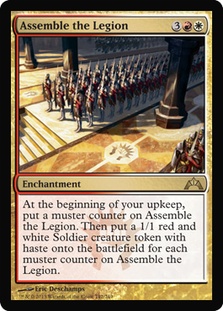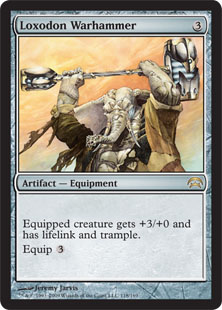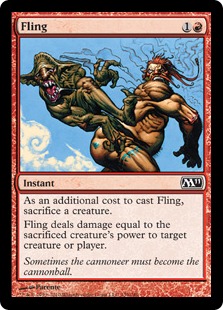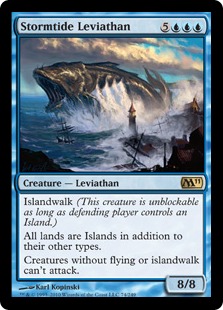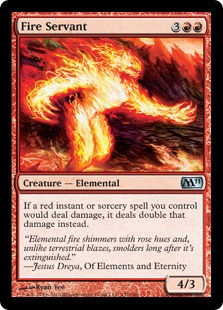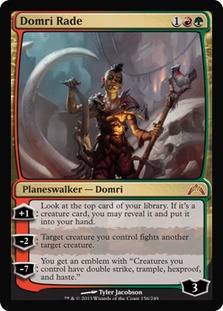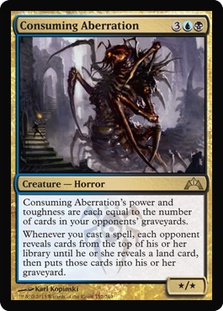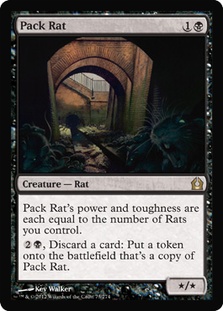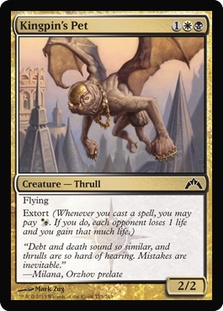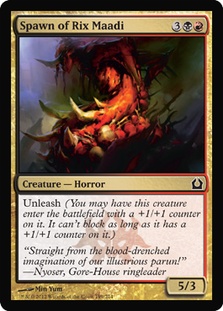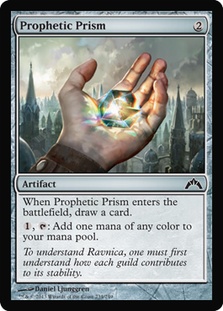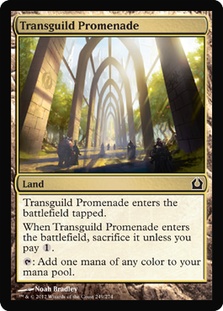I normally hate writing tournament reports like this, but it seems oddly appropriate here. Honestly, the strategic interactions aren’t what I care about from team events. Trying to win as much as possible is obviously the goal, but these events aren’t really about the result or trophies (though those are nice if they don’t break). I approach team events like a casual weekend with friends, and it’s the stories that matter here.
For the longest time, I hated team tournaments.
My first team tournament was a mono-Mirrodin Team Sealed for PTQ practice. I showed up with two friends, and we were way out of our depth. I’m not even sure I could properly build a Mirrodin team Sealed pool now, let alone back then. So much of your pool could go literally anywhere even after you make your color decisions. We still had fun, but the complexity capped how much we could get into the format. Return to Ravnica is a little nicer since it’s easier to argue over where to put an Assemble the Legion than a Loxodon Warhammer, but I can imagine this being an issue in the future.
My second team tournament was a Two-Headed Giant PTQ. My issue with this event was finding teammates. To be fair, I wasn’t completely committed to winning the event because I was still grinding the Junior Super Series and would lose my ability to do so by getting Pro Points, but I felt the building of teams was about exclusion instead of inclusion. The difficulties involved here turned me off to the format. It was another barrier to entering an event that I had less control of than I wanted. Looking back, it almost seems harder to find a two than a three since options close faster, but I can’t logically explain why.
When I first started on the Pro Tour, Team Limited was for all official purposes dead. Still, six-man drafts were something I always found myself excited to play in. Who was on my team didn’t really matter. The times were great, and the stories were ones I remembered. Even something as simple as a comically lopsided Italian Game for the rares provided a great time.
One such story was a draft after Pro Tour Amsterdam where Craig Wescoe, Jason Ford, and myself faced off against Chikara Nakajima and two other Japanese players. The draft ended 5-1 in our favor, with Craig Wescoe Flinging a Stormtide Leviathan with a Fire Servant in play. Other highlights included Jason Ford three Black Knights (one for each of their white decks) and the rest of the Japanese trying to get the opposing team to scoop the draft mid-pack 2. The three of us agreed that we would have first dibs on reassembling this trio should there ever be another team trios event. Unfortunately, neither Jason nor I planned on attending San Jose, and the deal lapsed.
For Providence, I teamed with two of my friends from Michigan: Matt Mccullough and Alex John. These aren’t household Magic names, but in terms of skill and team interaction, I couldn’t have asked for better.
Alex John is the person responsible for my Grand Prix Nashville finals appearance. He came up with the Dinosaurs archetype that carried me through the Sealed and all three drafts. He and DJ Kastner (another Michigan ringer) spent a massive amount of time drafting on Magic Online, often digging up strategies most people don’t think of. Alex was also a part of the most comically lopsided 3v3 I’ve ever played, where me and two "unknowns" from Michigan 5-1ed the (at the time) the two last Pro Tour winners and the Player of the Year. Matt Mccullough has hit a few Pro Tours in the last few years, with a Top 25 finish to show for it. He has yet to miss a Pro Tour day 2, largely due to his perfect Limited record on day 1.
Moving into the event, our pool was fairly average in terms of assembly. We had about eight Guildgates (one per pack of Dragon’s Maze, one per two packs of the other set) and quickly found a two-color deck (Gruul) that didn’t line up with any fixing for a splash. Blue was basically unplayable as a main color, which is true of a significantly large portion of pools. After that, there were two other obvious shells with a lot of complex decisions associated with them. A package of four Dega (W/B/R) Guildgates, a few real winners like Pack Rat and Warleader’s Helix, and a bunch of burn spells meant some deck existed there, but choosing a base guild was difficult. There was also an obvious Bant deck with around 31 possible playables that split into a few main packages, including a Growing Ranks plan.
In the end, we opted for Orzhov as the base of the first deck in order to find two-drops for our removal/burn heavy deck and played a very straightforward maindeck in the Bant deck without a lot of the possible flair. Our "normally good" cards in the latter deck had quite a few creature-conditional cards like Knightly Valor and Unflinching Courage, so adding Miming Slime and Growing Ranks would be a stretch and result in a lot of do-nothing hands. All three decks were powerful, but the Bant deck had the worst curve, mana, and rares.
Taking a step away from deck construction, let’s talk about our seating logic. I was definitely the worst Limited player on the team, but I was also the fastest by a large margin. Putting me in the middle seemed like the obvious choice as A) it meant I would have easier access to someone to answer quick questions and B) being done earliest in the middle makes helping out easier.
Moving on to what deck goes where, our primary assignment was based on play style. Alex often plays the wild multicolored green deck, even in two-color formats, so the Bant list was obviously his. We expected a lot of teams to follow the logic behind B), but both the Borzhov and Gruul decks seemed good in mirrors. In the end, I think some mix of arguments like "Matt is good with chip shot damage into lethal burn and loves Vizkopa Guildmage" and "I’m going to be stupid, so give me the deck with the mythics" won out, and I found myself in the middle with Domri Rade and Savageborn Hydra.
Some rough lists of notables in each deck:
Alex’s Bant
Lavinia of the Tenth
Beck // Call
All the five-drops, including two Armored Wolf Riders (aka Captain Unbeatable)
Unflinching Courage
Matt’s W/B/R
Pack Rat
All of the burn (Warleader’s Helix, Explosive Impact, Punish the Enemy, Toil // Trouble)
Our first round was a rocky start against Matt Ferrando squad. Alex got his, but I opted to trade off a Skarrg Guildmage early and lost because of it. Lesson learned; just because Guildmages were often just bears in Gatecrash doesn’t mean that still applies. At this point, Matt was down a game and behind, but a sequence of overly cautious plays on his opponent’s part let him rip one of his many burn spell outs and force a game 3 that he won with Toil // Trouble. Fortunately, we were there to remind him that Trouble does not in fact cost two to play and that 2 + 3 + 1 does not equal 7.
The rest of the rounds blurred together in a long sequence of watching my opponents struggle to beat my mythics and usually failing. We ended the day at 8-2, presumably needing to 5-0-1 or 5-1 and win a breaker war to make the final cut. Some of the highlights:
-My removal was two Pit Fights, a Domri Rade, and a Punish the Enemy the other red deck had sacrificed since it was too removal flooded. It turns out that if my opponent is playing things bigger than 3/3, this removal set gets a lot worse, and I ended up having to do a lot of work to fight Bloodfray Giants and Jelenn Sphinxes.
-One of the later rounds I played against Mani Davoudi, who had a deck that was solidly all the colors. I lost game 1 to Precinct Captain, and game 2 he played multiple different non-white Gates. His Prophetic Prism had let him do basically whatever he wanted those games, and I jokingly asked about a gentlemen’s agreement for me not to draw my Domri Rade while he doesn’t draw his Prophetic Prism. He laughed and rejected the offer by having turn 3 Prism game 3. I obviously had the Domri and proceeded to hit all the +1s while he missed land drops for an easy win.
-I won a game by casting Punish the Enemy targeting them and my creature.
-I would not be shocked if Alex’s average hand size was under six cards. He won a lot of these mulligan games, to be fair, including a post-board keep of four lands plus Growing Ranks on the play.
-Matt’s opponents repeatedly played incorrectly around removal going into the late game, giving him time to set up lethal burn spells instead of forcing him to trade them for creatures.
-Matt had quite a few turn 2 Pack Rats. It ended up dying a lot to exactly Ground Assault, and his end of the day statistic was that he went X-0 in games where Pack Rat entered play and activated once or zero times and 0-X in games where it activated twice or more.
Our day 2 fired off against Dan Jordan, Ben Friedman, and Max Brown. All three of them opened an awesome Boros card and none of them moved out, resulting in two of us getting passed Far // Away, one of us getting passed Exava, Rakdos Blood Witch after opening Master of Cruelties, and their decks being trainwrecks. I ended up in Dimir and was rewarded with a passed Consuming Aberration and Nightveil Specter pack 2 and an opened Pack Rat.
Who says Dimir is the weakest guild?
Matt mulled to five round 1 and played exactly one card (Mountain) in game 1, and by the time his mid-round deck check was over, Alex and I had won the match. The second round ended up being closer due to my deck’s poor matchup against Dan Jordan two-drop heavy deck, but Species Gorger bouncing Trostani’s Summoner took it home. Matt was able to reveal more cards this time around, showing some Swamps and the aforementioned Dragon’s Maze rares as well as his Clan Defiance.
The next draft I ended up in a solid no-rares Boros deck after getting passed a Warleader’s Helix, while Alex ended up in yet another four-color green deck. We were really confused as to what their decks were since they had passed on quite a few good ones, including a Vorel that got to Alex fifth, but their decks turned out the be fine. Round 1 was a relatively quick affair where the question of "how dead are you if your opponent turn 4 bloodrushes a Scorchwalker to put you to ten" was asked and answered, but round 2 dragged on as Matt’s BUG midrange deck faced off against their Esper deck.
We tried to get aggressive against a mana-screwed hand early, but our opponent stabilized at a middling life total. Matt had a 7/10 Mindeye Drake thanks to a Terrus Wurm, but our opponent’s Deathpact Angel was buying him a lot of time as an expensive Will-o’-the-Wisp. In the end, the entire opposing team was stumped by how to make blocks that beat our Simic Fluxmage, and on turn 2 of time we cleared their board on chumps to set up a kill on turn 4. Their top card wasn’t one of the two Mind Grinds that had been floating around, and we took it home.
After this, the standings showed us in third place with six teams at 36 points, one at 34, and one at 33 with better breakers than us. If we went 1-1, it would be a helluva coin flip to make it, and our opponents were the first seed and pretty much locked with just a single win. It was 6-0 Draft or die trying time.
Team events are brutally long, and by draft three it was really hitting me. I was borderline functional for the draft and was able to make correct picks, but I remembered basically none of what I passed. I assumed I had shipped an Orzhov shell with Tithe Drinker and up to three Profit // Loss, but packs 2 and 3 may as well have not existed. My deck was a Jund ramp deck with triple Zhur-Taa Druids and a wild assortment of six-drops to slam as well as my first pick Master of Cruelties.
I ran and got food-related items and caffeine to try to get myself functional in time to play, but it was a lost cause this round. It turned out it just didn’t matter. To paraphrase one of my past Grand Prix opponents:
I think I made zero correct attacks game 2.
I bloodrushed a Ghor-Clan Rampager on my Master of Cruelties assuming it triggered on damage dealt and switched multiple times between my two kill options of Master and regular damage, but even despite this The Abyss was just too much for him to handle. While Matt’s near Constructed-level Gruul aggro deck failed to get there this round, Alex had the game 3 beatdown curve of Cloudfin Raptor, Kingpin’s Pet, Assault Griffin, Spawn of Rix Maadi to take down his match and keep us in the hunt.
Yes, that is real life.
After a brief look, it was confirmed the next round was the all or nothing one despite us being in first place. Our opponents were locks with a win, and I had been a little over the top the previous round, so a scoop was approximately 0% to happen. Fortunately, we drew the dream pairing. Matt’s aggro deck got to bash their clunky control deck, I got to be the bigger green deck in a mirror, and Alex just kept doing what he was doing. Matt and I each dropped a game, but we both took our matches down with Alex up in game 2.
One casual 6-0 and we had first seed. Not only did this mean we all were on the play (or draw) in our semifinals match, but we also had the play (or draw) locked for all three potential finals matches. This is a huge swing, and I feel like it is almost too powerful. I would have accepted just being on the play match one and having the previous match’s loser choose for each subsequent round.
But it was far from over. After some representative photos of how I was carried to this finish, we had some opponents to beat. Alex set up a classic pass-cut involving taking Kraul Warrior over Zhur-Taa Druid and getting a slightly worse Boros card through, resulting in the guy between us getting cut out of red pack 2 and green pack 3. There was a ton of Selesnya floating around pack 3, and I ended up with a Guildgate to splash a Gruul War Chant as well as a Courser’s Accord and Grove of the Guardian that I boarded in against my opponent’s grindy Junk deck. Matt’s Jund Rock deck easily dispatched the pinned Gruul deck, and Scorchwalker as Lava Axe locked up my game 3, which left us one more set of opponents to go.
In deckbuilding, I honestly thought we just had it. Matt and I had two really awesome Boros decks despite fighting over the colors. With five Viashino Firstblades and all of the Gatecrash two-drops, there was more than enough to go around. Unfortunately, Matt’s deck didn’t cooperate, and Vizkopa Blood Baron is a bit of a monster. It happens, and this is why we play the matches.
If you want strategy pointers for the format, the one tip I can give is to remember that every piece of fixing you have is one that they don’t. Cards like Prophetic Prism and Transguild Promenade that offer universal fixing gain a lot of value here as your opponents not having them often means free match wins.
That said, the best strategy pointer I can give comes full circle. Find people you will have fun with. The best three players in the world will fail miserably if they are constantly arguing with each other, though Juza-Stark-Nakamura shows that most of the best players are friends to begin with. When choosing between a slightly better partner who you are less friendly with and someone you want to be around all day, the right call should be clear.
Trust me. I’m all about playing for the victory at every other event. I am a Spike through and through. But in this case, the feel-good play is also the highest percentage one.
Doing well with friends at a team event means you have plus two friends on the Pro Tour. What could possibly be better than that?
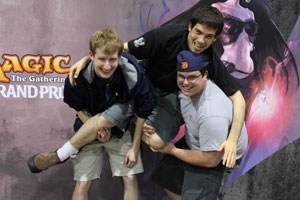
You can check out all the coverage of Grand Prix Providence here!

